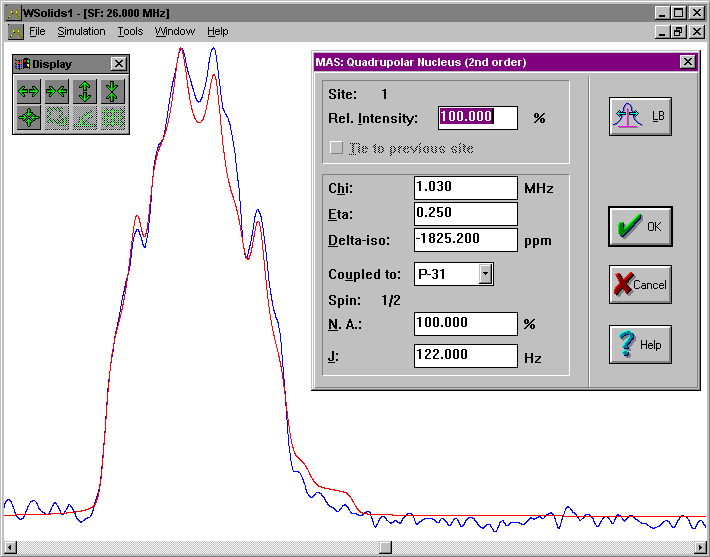[Uni Tübingen] - [Mat.-Nat. Fakultät] - [Fachbereich Chemie] - [Anorg. Chemie] - [Klaus Eichele] - [Software] - [WSolids1] - Quadrupolar Nucleus

|
WSOLIDS1:
|
Description
This squeezed picture shows an example for the succesful simulation of a MAS spectrum of a quadrupolar nucleus that shows the combined effect of quadrupolar interaction and spin-spin coupling to a spin-1/2 nucleus in a powder sample. It is the 95Mo NMR MAS spectrum of pentacarbonyl-5-methyldibenzophosphole molybdenum(0), Mo(CO)5(MeDBP), and the results have been published in:
K. Eichele, R. E. Wasylishen, J. H. Nelson:
Solid-State 95Mo NMR Studies of Some Prototypal Molybdenum Compounds: Sodium
Molybdate Dihydrate, Hexacarbonylmolybdenum, and Pentacarbonyl Phosphine
Molybdenum (0) Complexes.
J. Phys. Chem. A 1997, 101, 5463-5468.
Click on the picture to have a better look.
Background
If the nuclear quadrupolar coupling for a quadrupolar nucleus is sufficiently large, MAS cannot remove its effect on the line shape of the central transition and causes second-order broadening with characteristic lineshapes as well as a second-order shift. In order to obtain correct chemical shifts for the quadrupolar nucleus, simulation of the spectra is required. Optionally, indirect coupling to a heteronucleus can be added (note: quadrupolar interaction, if any, is neglected for the coupled heteronucleus).
Examples
The SVG images shown below were produced using the following tools: my own SpecPlot to plot the spectra, Platon or Ortep 3 for Windows to plot the molecular structures from X-ray data, and Inkscape to compose the picture.
[ Anorg. Chemie ] | [ Go Home ] | webm@ster | last modified: 20.02.2024


